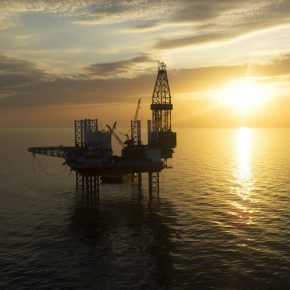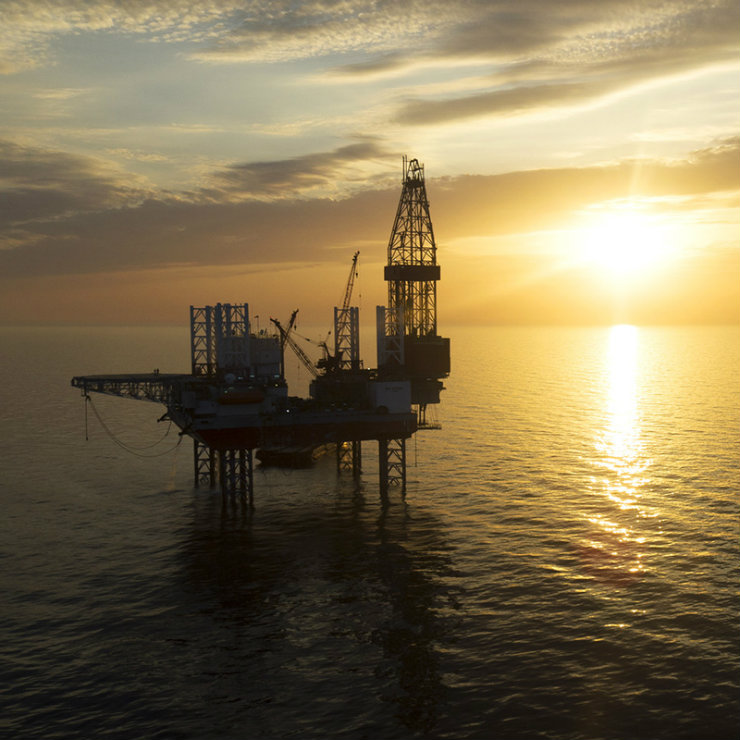Tydzień w gospodarce
Category: Trendy gospodarcze
Analyst, journalist specializing in the Western Balkans and Middle East domestic and foreign affairs

Iulia-1 well, Black Sea, Romania (Black Sea Oil & Gas, Public domain)
Romania began its gas exploration for the first time in the Black Sea 50 years ago, at the time of rule of Nicolae Ceauşescu, so Russians had all the information available at the Soviet Union times. Now, there is a lot of talking that Romania might prove to be an alternative to the Russian gas exports. According to the country’s energy minister, Anton Anton, Romania can become a „regional hub” and contribute to the energy security of Europe, though the total assumed, non-proven reserves are the amount Russia is delivering annually to Europe through existing gas pipelines.
Six years ago, the US ExxonMobile and Romanian Petroleum Company Petrom, owned by the Austrian OMV, found a gas site 170 kilometres from the Romanian shore. It is estimated that the site hides 84 billion cubic meters (bcm) of gas. The site should significantly increase Romanian production and export of natural gas. Namely, unlike most of the EU countries relying on Russian gas imports, Romania is practically independent in energy terms. Most of the gas production is owned by the state-owned company Romgaz and Petrom, and each year they produce about 10.5 bcm of gas, mostly from land sites.
Given that Romanian households and industry spend between 9 and 11 bcm a year, Romania imports only 10 per cent of their needs. Romania is practically independent of gas supply from Russia. According to various estimates, the unused reserves below the Black Sea range from 170 to 200 bcm and can be exploited by 2040. This amount covers Romania’s needs for 15 years.
Hungary was the first to show interest in the import of Romanian gas to cover half of its needs, and this will start in 2022. Companies such as Exxon, Petrom, Lukoil and Carlyle have invested nearly USD2bn in the gas exploration in the Black Sea in the last ten years. But for the further development another USD1bn is needed. However, OMV’s CEO, Rainer Seele, recently have said that the Austrian company cannot make a decision on the further investment. As Financial Times reports, Petrom’s spokesperson stressed that the company is studying hydrocarbon production law in the underwater to understand how it will affect investment decisions and operations at underwater sites.
The investors are challenged by a law requiring companies to sell at least half of the gas on the Romanian market. In addition, as tax relief, companies account for only 30 per cent of the amount invested in the development of gas deposits, instead of the previously announced 60 per cent. The Bucharest government plans to have, thanks to this bill, around USD20bn of budget revenues in the next twenty years. Deloitte’s study estimates budget revenues by 2040 up to USD26bn and USD40bn in Romanian contribution to GDP. The energy expert argues that the new law has made Romania the least attractive state in the Black Sea area for gas production. The Concessionaire Association ARCOMN, however, warns that tax stability is completely shaken by this law, making investment decisions impossible.
The cost of the project is estimated at USD3bn, and after the funds invested, OMV and Exxon have to pay substantial revenues from the proceeds. According to current prices and plans, the exploitation of OMV and Exxon would cost around EUR500m a year. For experts the departure of foreign companies or the pressure on the government in Bucharest is the most common business interest. Even existing agreements with users are revoked. Production in Neptune Block in the Black Sea can only be 6.3 bcm a year, and the US company Exxon Mobil has signed a document on a strategic partnership with Hungary, according to which the neighboring country can get 4.4 bcm of gas from the Black Sea Fields.
At the same time, the European Union supports alternative solutions to the Russian gas imports. Romanian state-owned gas transporter Transgaz received a financial help to develop the gas transport network in Romania’s north-east region of Moldova, that will also be continued into the neighboring state of the same name. The contract is worth EUR152m, of which EUR46m are from the EU funds. The gas pipeline will connect Ungheni, at Moldova’s border with Romania, and the Moldovan capital Chisinau. This is a continuation of good relations od Transgaz with the EU funding. In the last two years, this company contracted EUR250m of EU funds, most of which have been spent for the creation of BRUA pipeline project, which connects Romania and Bulgaria with Hungary and Austria and which should allow export of Black Sea gas to the countries of Western Europe.
„Romania will be a gas hub and can even become the largest gas producer in the European Union. If we are to produce gas from the Black Sea, after Brexit we will be the first gas producers in the EU,” Romanian energy minister Anton Anton said.
The Business Times argues that Russia is still the largest energy supplier in Europe, but Romania has started seriously exploring and producing oil and gas from the Black Sea areas. The proven reserves are apparently sufficient for the complete self-sufficiency of Romania for 15 years, but Bucharest is also expecting to share part of its resources with its neighbors in the CSE.
„The position of Romania as a potentially large gas producer in the region is unique, and these resources may pose a threat to the de facto Russian monopoly,” said Mark Beac, president of the consortium Black Sea Oil & Gas, a jointly owned company of Carlyle Group and the European Bank for Reconstruction and Development.
Still, to develop its potential Romania needs investments from the energy companies. The government sees a good opportunity in taxes. But Romania has no infrastructure for transport and consumption of energy resources, and there is no guarantee that any progress will be made in this area. For example, only a third of households in cities are connected to the gas network, while in rural areas people use wood for heating.
In any case, gas production in Romania can provide for energy independence, but will have little impact on the balance on the growing European gas market. This year Gazprom plans to export to the EU countries at least 200 bcm of gas, and according to the new Romanian law, investors will be able to export just over 3 bcm a year. In Europe itself, with more than noticeable growth in consumption, the other side is expecting a much more serious decline in production. For example, in 2020, the Dutch production authorities on the largest European field, the Groningen area, will be reduced to 12 bcm. Under these conditions, Romania will hardly become a European natural gas force, especially because of a much cheaper gas from other supplies, both existing and those under construction.
Vedran Obućina is an analyst and a journalist specializing in the Croatian and Middle East domestic and foreign affairs. He is the Secretary of the Society for Mediterranean Studies at the University of Rijeka and a Foreign Affairs Analyst at The Atlantic Post.

